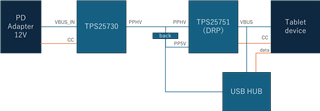Other Parts Discussed in Thread: TPS25751
Tool/software:
Hi team,
I am considering a configuration that combines the TPS25730D and TPS25751D. The TPS25730D is connected to a PD adapter, which charges the device at 12V through the PPHV of the TPS25751D.
When the PD adapter is disconnected, the device will supply power internally through VBUS.
In other words, I want the TPS25751D to act as a DRP.
So I have the following questions.
1.When the PD adapter is disconnected, the PPHV of the TPS25730 continues to receive power from the device.
Is there any concern about heat generation?
2. When the PD adapter is connected from state 1, is there a problem with the voltage batting?
Best Regards,
Ryu.


